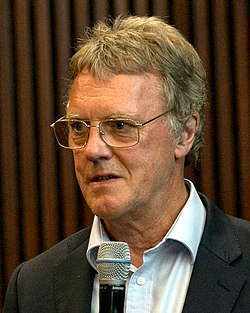Peter J. Ratcliffe | |
|---|---|
 Ratcliffe in 2019 | |
| Born | Peter John Ratcliffe 14 May 1954 |
| Education | Gonville and Caius College, Cambridge St Bartholomew's Hospital Medical College |
| Awards | Fellow of the Royal Society Albert Lasker Award for Basic Medical Research Physiological Society Annual Review Prize Lecture Louis-Jeantet Prize for Medicine Knight Bachelor Fellow of the Academy of Medical Sciences EMBO Membership Baly Medal Grand Prix scientifique de la Fondation Lefoulon-Delalande Robert J. and Claire Pasarow Foundation Medical Research Award Nobel Prize in Physiology or Medicine |
| Scientific career | |
| Institutions | Francis Crick Institute Nuffield Department of Population Health, University of Oxford |
| Website | Official website |
Sir Peter John Ratcliffe, FRS, FMedSci (born 14 May 1954) is a British physician-scientist who is trained as a nephrologist. [1] [2] [3] He was a practising clinician at the John Radcliffe Hospital, Oxford and Nuffield Professor of Clinical Medicine and head of the Nuffield Department of Clinical Medicine at the University of Oxford from 2004 to 2016. He has been a Fellow of Magdalen College, Oxford since 2004. In 2016 he became Clinical Research Director at the Francis Crick Institute, [4] retaining a position at Oxford as a member of the Ludwig Institute of Cancer Research and director of the Target Discovery Institute, University of Oxford. [5]
Contents
- Education and training
- Career
- Research
- Personal life
- Selected honours and awards
- References
- External links
Ratcliffe is best known for his work on cellular reactions to hypoxia, for which he shared the 2019 Nobel Prize in Physiology or Medicine with William Kaelin Jr. and Gregg L. Semenza. [6] [7]

